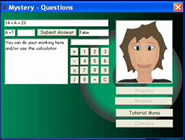Outcomes


In the video clips he used as part of his documentation, Zach explains how he carefully designed his Algebra program 'Mystery' to entice the users of his program into the mystical world of algebra, letting them choose their level of difficulty, and work at a gradual pace so they could feel a sense of success and become confident kids. He explains how he carefully choose wording that would not shatter this confidence.
In considering the needs of others, Zach enjoyed learning and felt a huge sense of success himself, becoming technologically proficient and very much a 'confident kid'.
Zach's explains 'Mystery'
Stakeholder feedback was just as positive. "The ESOL teacher was pleased with the outcomes," Jenny says, "and wants to continue the relationship. They found our students talking with their students gave them more language practice. The lady from the Learning Support Unit also thought that the pairing up we made worked out really well. An ICT student with writing difficulties was paired with the unit addressing reading difficulties and the relationship worked out to the advantage of both parties."
Assessing ICT teaching through written means is difficult, given that much of the content is visual. Jenny wanted to gather evidence of achievement in the most appropriate way for not only the subject but also her students, some of whom did not have English as their first language. As a result, she assessed the students throughout the year using the alternative assessment schedule jointly developed by the Beacon Practice Cluster and Hugh Derham.
Did gender have any influence on the level of engagement in the project and the outcomes achieved? None at all, says Jenny. "This wasn't an issue. The students were designing computer programs to help young people with learning difficulties. All the students were "confident kids' themselves and were keen to assist others to become so."
In terms of time management, the year panned out reasonably well. "We were very happy with the balance we achieved in our teaching plan for the year. However with the change from visiting assessors to having to send work away for external assessment, we lost three weeks at the end of term four and intend revising our annual plan."
"We were also very happy with the balance we achieved between skills development and tech practice. Skills and knowledge were taught in the first two modules and then extended throughout the major project. Tech practice was embedded into the natural development of each of the three projects."
The Components of Practice diagram successfully provided a framework for planning, teaching, and assessing the unit. "It explained to the students why they were doing things, making them see each activity or skill was part of a learning process, rather than a stand-alone task."
In the past, students spent a lot of time writing briefs and plans, Jenny says. "By the time they got to create their project they'd lost the impetus. Now it's very clear that it is all part of one process. It comes back to the point about the practice being enhanced; the reason they're doing the planning is that it should lead to a better brief, which should lead to a better outcome. And so rather than being an artificial hurdle it's a valid step in the process that actually enhances the practice and improves the quality of the outcome."
Jenny says she is happy with the 'depth' of the main project and the range of skills it demands. "At level one the process and the programming language is new to the students and the content is quite demanding."
Almost all of the students in the 2006 class returned for year 12 Technology. "One of our aims of the Beacon Project was to bring back the bright students and to make learning ICT in a Technology context enjoyable for both teachers and students. Our external results and student retention has shown we have been successful in this aim."
Student Evaluation
"The 2006 ITP course taught by Mrs Baker gave her students the opportunity to seek knowledge in their favoured areas in computing while still obtaining the vital knowledge of ICT programming and technological practice. By supporting us as we pursued our individual studies for our unique projects, we were able to keep motivated and enthusiastic about the course as it was tailored for us as individuals, while still providing us with the foundation knowledge of programming in Visual Basic, planning using various methods and graphic design. With this essential knowledge we were able to complete our projects on time and to a high standard; with our individual pursuits and Mrs. Baker's support in that, we were able to proudly present high quality work that was both efficient and aesthetically pleasing.
"The issue to create a program that would help kids to become confident brought with it openness for a diverse range of programs and an opportunity for us to provide a resource for younger people to attain the skills they need to become confident in the areas that we feel perhaps such a resource could have been beneficial to us growing up. Personally, I chose to create a program that would help children to grasp the idea of substitution algebra that was fun and at the appropriate level for them which they identified themselves, to give them a head start in maths and confidence as they learned at their own pace and were not being compared to their peers. With our modern world being based largely on maths it is essential that kids grow up confident in this subject so that they can succeed in the world."
